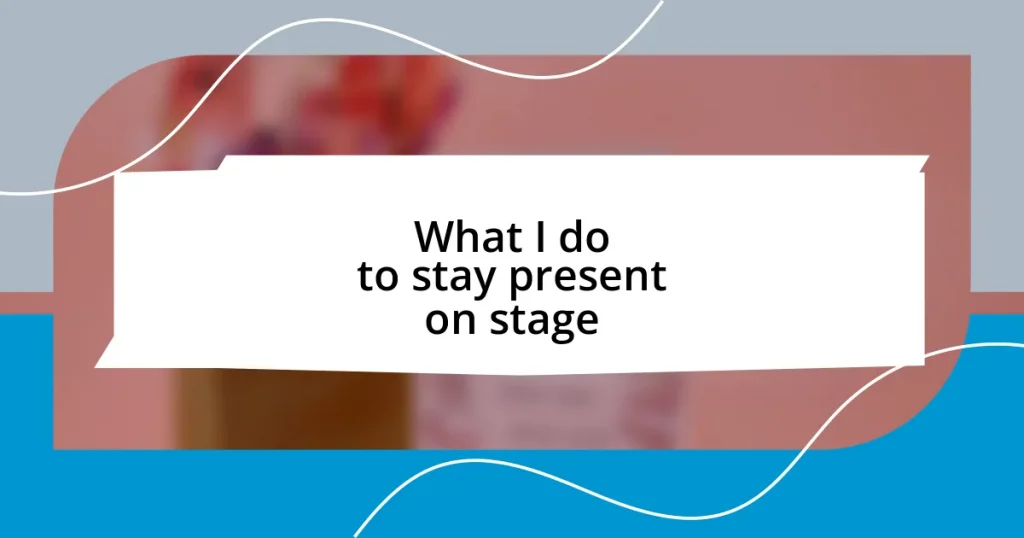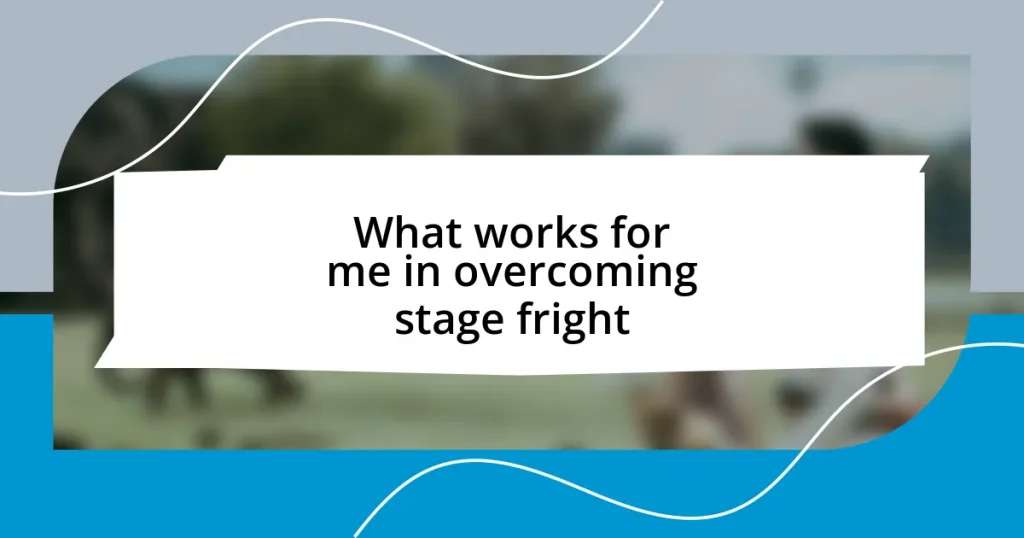Key takeaways:
- Jazz standards serve as a foundation for improvisation, allowing musicians to communicate and collaborate beyond cultural barriers.
- Key components of jazz standards include melody, chords, and lyrics, each contributing to emotional depth and storytelling.
- Common chord progressions like I-vi-ii-V and ii-V-I are essential for creating structure and facilitating improvisation.
- Practicing jazz standards involves listening to various renditions, isolating challenging sections, and jamming with others to enhance adaptability and personal expression.
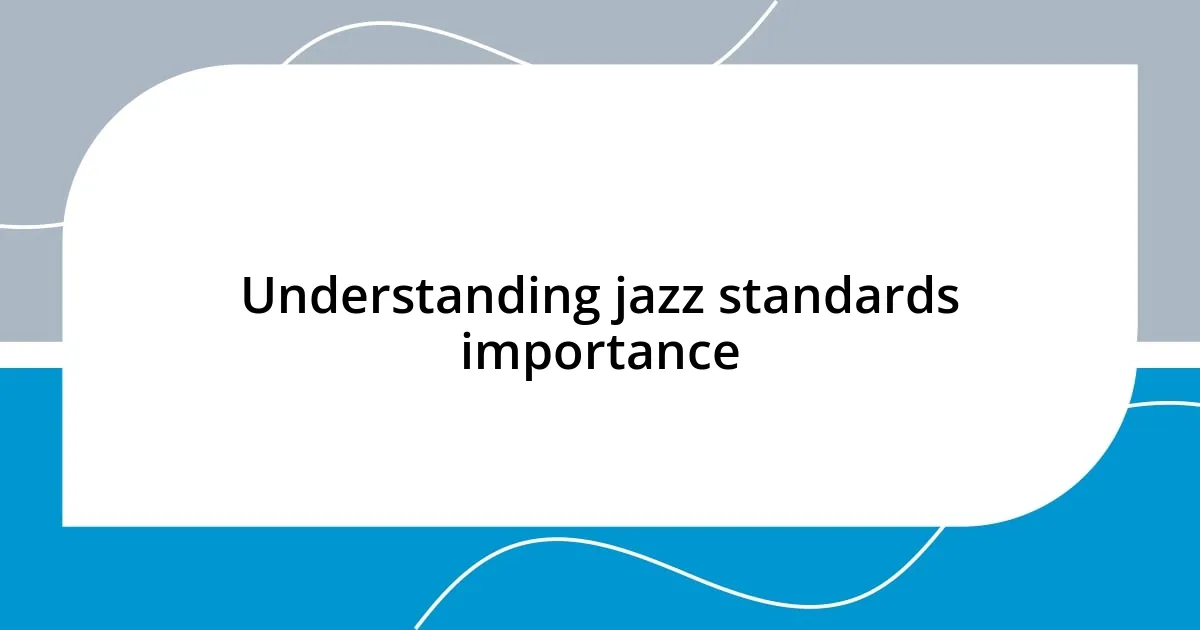
Understanding jazz standards importance
Jazz standards hold a unique importance in the world of music, acting as a common language among musicians. When I first started playing jazz, I often ran into musicians who would casually mention standards as if they were old friends. This deep connection made me curious: why are these songs so essential? I realized that they serve as a foundation for improvisation and creativity, allowing both beginners and seasoned artists to communicate through music.
One of my most memorable jam sessions was when I stumbled into a local jazz club. The moment the band launched into a familiar standard, I felt an electric sense of unity. I wasn’t just a spectator; I became part of a shared experience transcending language and culture. This is the beauty of jazz standards—they bring us together, bridging gaps and fostering collaboration.
Understanding the significance of these pieces can ignite a passion for jazz in anyone. It’s fascinating to think about how many people have interpreted the same melody across decades. Isn’t it remarkable that a single composition can inspire such diverse emotional expressions? These standards are more than just notes on a page; they’re living monuments to artistic freedom and collaboration.
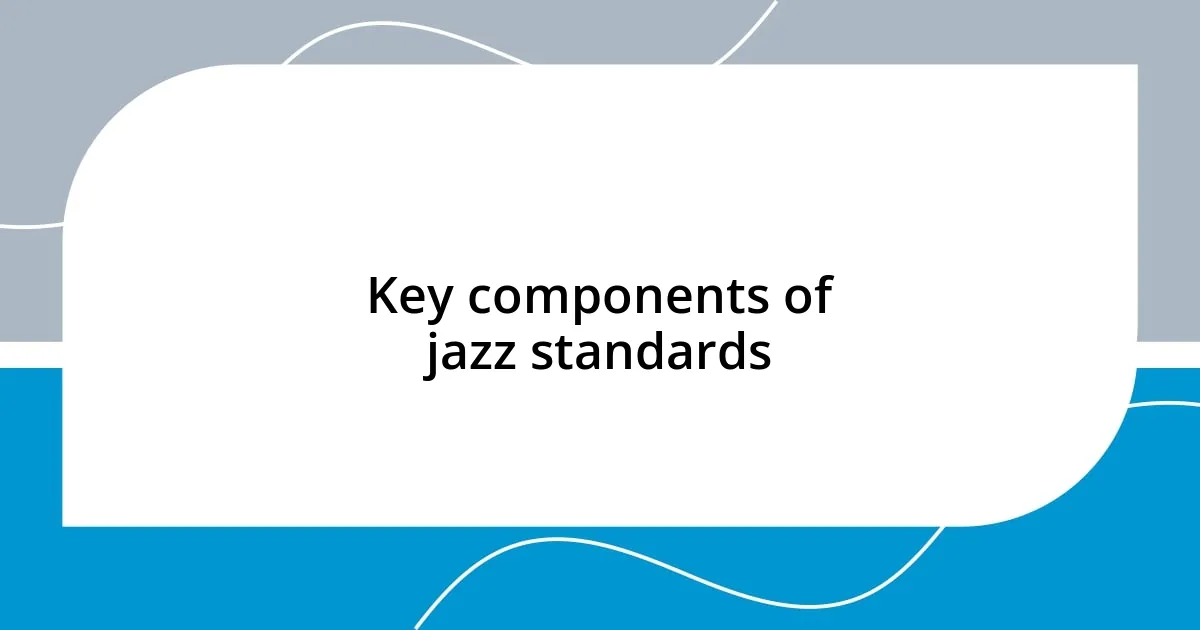
Key components of jazz standards
Jazz standards are built on a few essential components that help define their unique character. The melody often acts as the centerpiece, forging an emotional connection that is deeply felt by both musicians and listeners. I recall playing “Autumn Leaves” for the first time; its haunting melody lingered long after we finished, revealing layers of nostalgia and longing within its simple yet profound structure.
Chords and harmonies are another critical element, providing the framework on which the melody dances. I’ve learned that many standards utilize common chord progressions, such as the ever-popular ii-V-I. This repetition allows musicians to innovate within a familiar context, creating a blend of structure and freedom that’s so vital in jazz. During one group rehearsal, experimentation with these chords led to an exhilarating moment where we collectively discovered a new groove that felt refreshingly unique.
The lyrics, when present, often encapsulate a story or emotion that enhances the overall experience. Songs like “Georgia on My Mind” resonate with anyone who has ever felt a powerful connection to a place or person. When I sang the lyrics in a small gathering, the shared nostalgia in the room was palpable, reminding me of the profound impact that words can have when paired with melody.
| Component | Description |
|---|---|
| Melody | The main theme that evokes emotion and connection. |
| Chords | Harmonies that create a structure for improvisation. |
| Lyrics | Words that add depth and storytelling elements to the standard. |
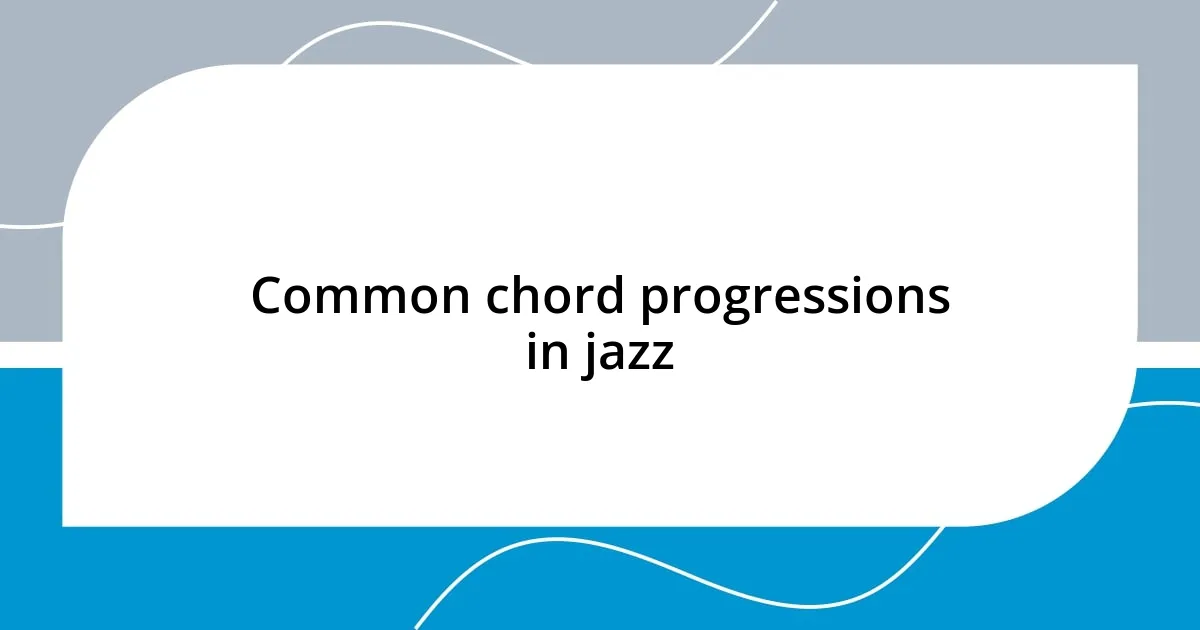
Common chord progressions in jazz
Jazz is rich with characteristic chord progressions that create the sonic landscape for improvisation. I’ve often found myself mesmerized by the subtle intricacies of these progressions during sessions. One standout moment happened during a late-night jam where we cycled through a classic I-vi-ii-V progression. It’s amazing how just a handful of chords can evolve through different interpretations, sparking unique conversations among musicians as each player builds on the last with their creativity.
A few common chord progressions that frequently appear in jazz standards include:
- I-vi-ii-V: A staple in many compositions, providing a sense of resolution and movement.
- ii-V-I: Known as the backbone of jazz harmony, it creates a strong sense of closure and is often used to lead into a new phrase.
- I-IV-vi-V: Often brings a feeling of brightness and drive, making it a favorite for upbeat tunes.
- I-ii-IV-V: This can evoke a more classical feel while still feeling fresh and uplifting.
During one amusing rehearsal, we took a common ii-V-I progression and decided to mix it up. Suddenly, instead of the expected resolution, we veered off into unexpected territory, transforming the mood of the piece entirely. It reminded me just how powerful and adaptable these common progressions can be; they serve not just as a template but as a launching pad for moments of pure musical magic.
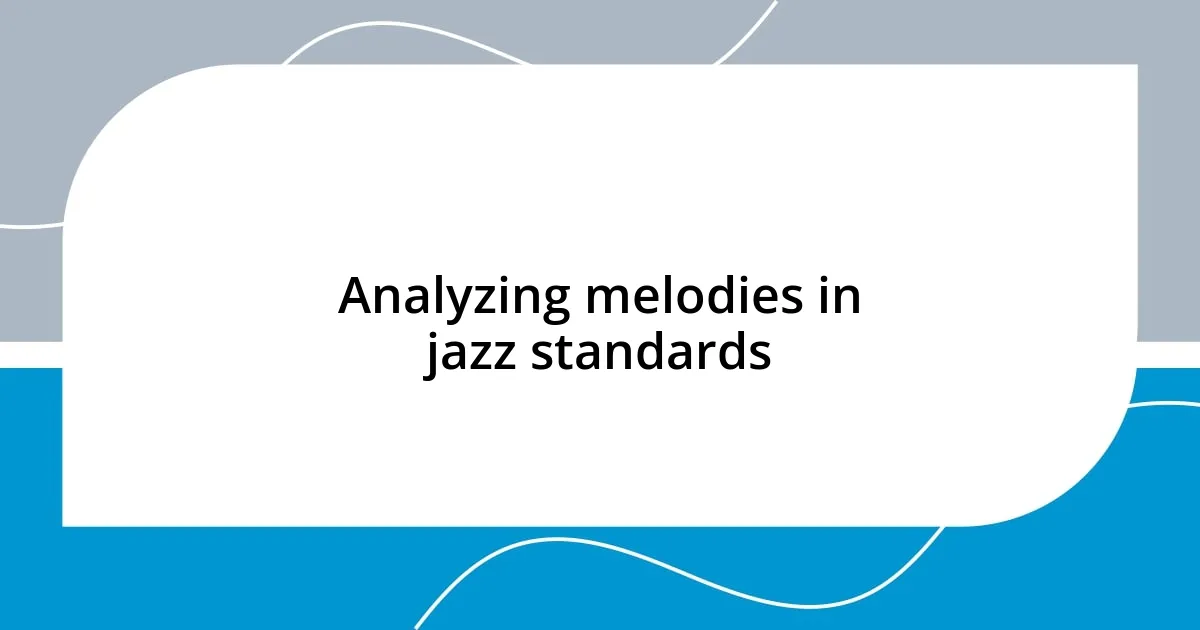
Analyzing melodies in jazz standards
When I dive into the melodies of jazz standards, I’m often struck by their emotional depth. Take “Blue Bossa,” for instance. The melody dances between major and minor notes, creating a bittersweet feeling that’s hard to shake off. I remember playing this tune with a small group; the way we interpreted those subtle shifts in the melody brought out intense reactions from the audience—could there be anything more powerful than music that resonates at such a deep emotional level?
Melodies in jazz often follow simple structures but pack an incredible punch. I’ve noticed that the most memorable tunes usually consist of repetitive phrases that are laced with variations. This prompts me to wonder, how can such simplistic foundations lead to such profound musical experiences? When I played “Take the ‘A’ Train,” the variations in the melody allowed for my improvisation to flow effortlessly, where each note seemed to build upon a shared musical vocabulary that felt almost telepathic among my fellow musicians.
Furthermore, examining how melodies weave through the different takes on a standard reveals a great deal about musical storytelling. One time, I was in a workshop where we explored “Misty.” Each musician brought their own flair through slight changes in phrasing and dynamics, reinterpreting the melody in real time. That experience highlighted how a single melody can take on multiple narratives, each interpretation creating its unique emotional landscape—don’t you just love how music allows us to explore and express feelings that might otherwise remain unvoiced?
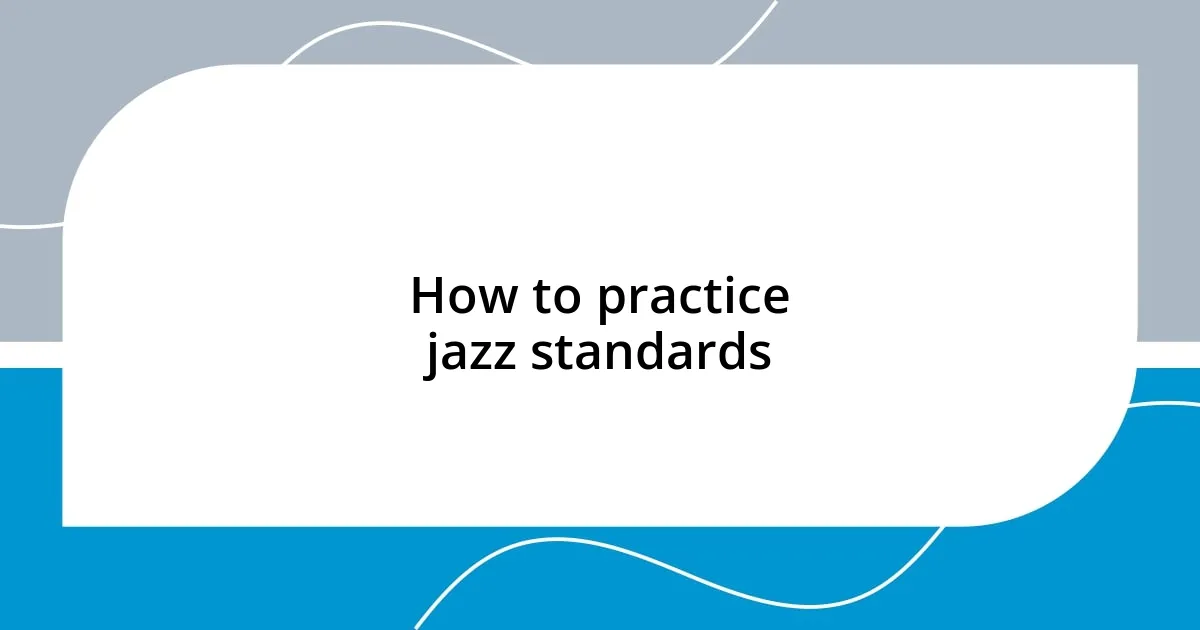
How to practice jazz standards
Practicing jazz standards involves immersing yourself in the essence of each piece. I often begin by listening to various renditions of a tune. For instance, when I first tackled “Autumn Leaves,” hearing different interpretations opened my eyes to the emotional nuances I could explore. It helped me appreciate the melodic variations that musicians bring, making the practice process not just about memorization but also about feeling.
Once I’ve absorbed the essence, I like to isolate challenging sections. Just last week, I found “All The Things You Are” to be a bit daunting. So, I broke it down, practicing each chord progression slowly, then layering in the melody. It’s fascinating to witness how when I focus on these smaller fragments, I can connect those dots into a more coherent whole. I often ask myself, how can I infuse my personality into the music? And relentless practice eventually leads me to answer that question through my unique interpretations.
Additionally, I think jamming with others is crucial when honing jazz standards. I remember a night spent at a local club where we all took turns improvising over “Blue Monk.” The spontaneous interplay between musicians transformed my understanding of a standard’s rhythm and flow. It’s in those moments of collaboration that I realized the importance of adaptability in jazz. How often will you find individual voices becoming one seamless conversation? That synergy is what makes practice vibrant and exciting.

Applying lessons to original compositions
When I start working on my original compositions, the lessons from jazz standards serve as a constant reminder of the power of simplicity and emotional resonance. For example, while writing a new piece, I often think back to how essential it is to begin with a strong melodic hook. I remember a late-night session where I jotted down a simple motif on my guitar. That motif turned into a full band arrangement, and it all stemmed from grasping that core idea—a little repetition with subtle variations can create a lasting impact. Isn’t it incredible how a singular thought can blossom into something expansive?
One technique I particularly love is utilizing jazz chord progressions in my original works. I once played around with the changes from “All The Things You Are,” and it transformed how I approached harmonic development. This fresh perspective liberated my creativity, allowing me to layer unexpected melodies that grew organically from those foundational chords. Have you ever experienced how a single chord progression can open up so many avenues for exploration? I’ve found that allowing those familiar structures to blend into my own style can yield powerful results.
Moreover, I often reflect on improvisation as an essential ingredient. While composing, I consciously leave space for spontaneous ideas, much like the collaborative sessions I’ve had with fellow musicians. In one memorable jam, I set a framework and then just let it evolve as we played. This approach taught me that sometimes the best ideas don’t come from meticulous planning but from embracing the moment. How liberating is it to let go and let the music guide you? Whenever I incorporate that sense of freedom into my writing, it inspires me to capture the essence of life’s unpredictability in my music.















